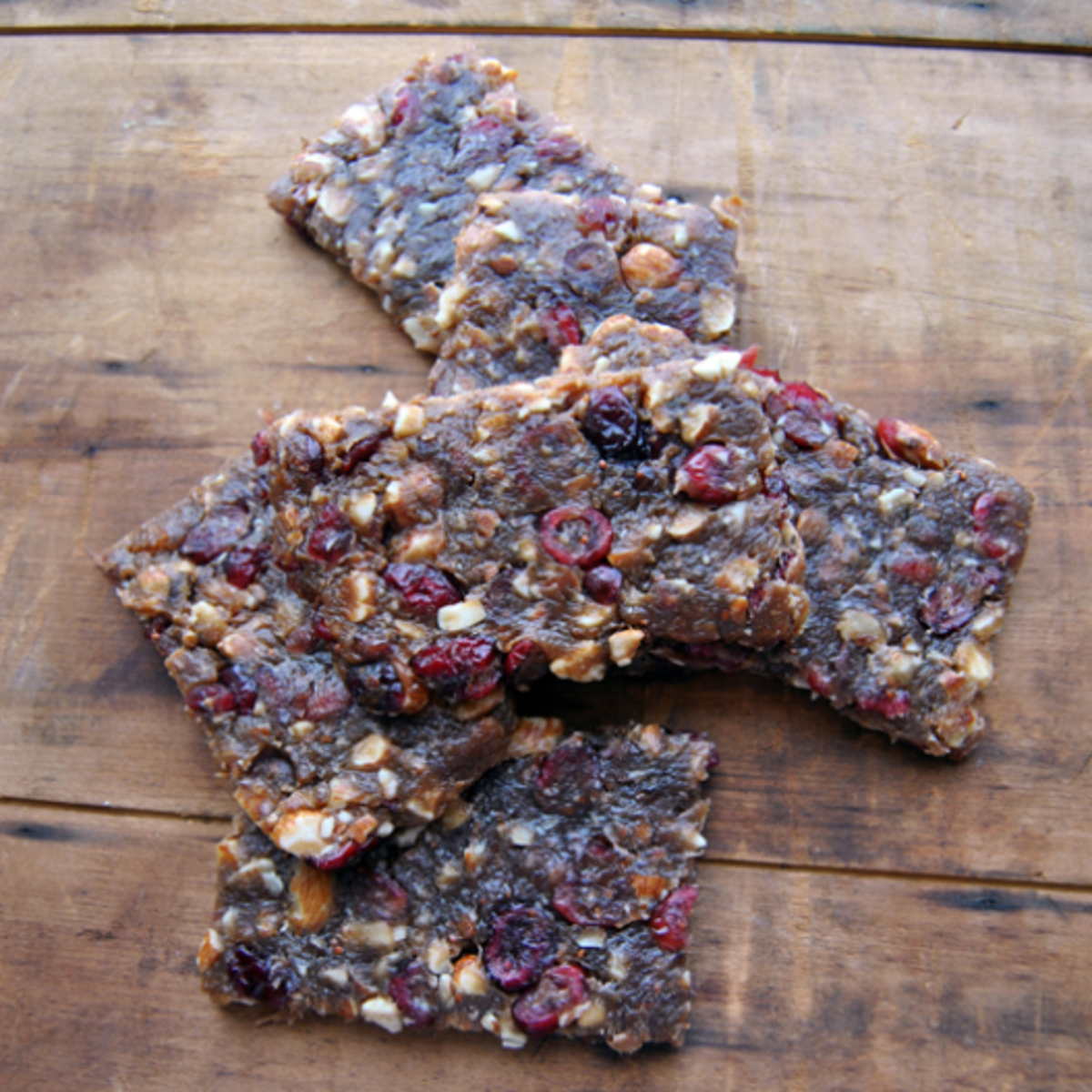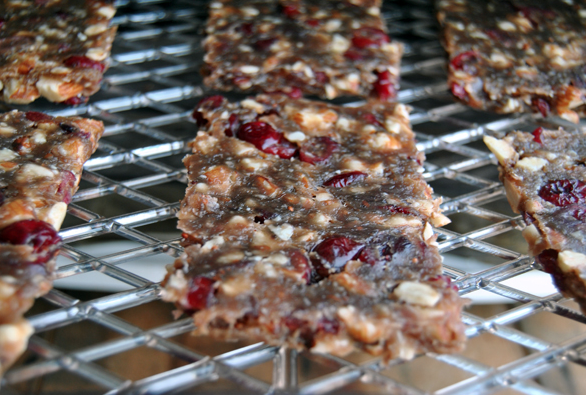
Course
Small Bites
Trail food is an essential part of any hunter’s kit. Snacking in the field keeps your energy level up whether you’re burning calories on long hikes or sitting in a blind all day. This is especially true in cold conditions. On most MeatEater hunts, various bars, jerky, and trail mix make up a huge part of our daily caloric intake. The best trail snacks are easy to carry, don’t spoil, and blend energy-rich fats, proteins, and carbohydrates.
Long before prepackaged trail food, Native American hunters made their own version of today’s protein bars and trail mix called pemmican. The word pemmican is derived from the Cree word, pimihkan. The root of pimihkan, pimi, means fat. Many Native American tribes had their own version of pemmican. Later, European fur trappers and explorers adopted it for their own use in the New World. Pemmican ingredients varied widely, but they always included lean venison or buffalo meat mixed with fat. Some pemmican recipes also incorporated dried berries and nuts for added flavor and nutrition. The basic process for making pemmican involved pounding dried meat into a rough powder and then mixing it with an equal amount of rendered fat. After processing, the shelf life of pemmican is measured in years rather than days. It was the ideal trail food that could be eaten as is or cooked and rehydrated in stews.
It seems pemmican was so important to ancient hunters that it was produced in large-scale operations. Recently, researchers unearthed a pemmican production site used by ancestors of the Blackfoot people in north-central Montana. Excavations revealed fire pits, tools, and bones used for processing pemmican near a Native American bison hunting area known as Kutoyis.
For modern hunters, pemmican is experiencing a bit of a revival-or least the term is. Several protein bar producers are using “pemmican” in their marketing materials, though many of these offerings have little in common with traditional pemmican. The best way to experience the real deal is to make pemmican with your own wild game, which is an easy and fun chore.
Pemmican combines all the best attributes of jerky, trail mix, and energy bars into the ultimate trail food. It’s portable, lasts forever, and packs a nutritional punch. If you’re wondering what to do with some of your older cuts of venison in the bottom of the freezer, now is the time to use some of it to make pemmican for this fall’s hunting seasons
For more information on Native American pemmican and bison hunting check out this article.
Ingredients
- 1 lb venison jerky
- 1 lb rendered bear fat or substitute with wild boar fat, beef suet etc.
- ½ lb dried cranberries, blueberries etc.
- ½ lb pine nuts or substitute with cashews or walnuts
All ingredients are mixed in equal ratios so it’s easy to adjust for quantity.
Preparation
Drying meat is a simple process that can be done in the oven or a dehydrator. But instead of using plain dried meat, you can also use jerky. The salt cure will increase shelf-life and add flavor. Try using this recipe.
Whether you are using jerky or plain dried meat, you must have a very dry product to make pemmican properly. You want jerky that cracks and crumbles when bent. Grind the dried meat or jerky into a rough powder. You can use a food processor to do this quickly. Do the same with the dried berries and nuts.
Next, you’ll need to mix the dry ingredients with rendered (cooked and liquefied) fat. Here’s Steve’s method for rendering bear fat. You can substitute duck fat, pork fat or beef suet for bear fat.
Once the pemmican is well-mixed, you’ll need to pour it into a mold to set up. Muffin pans or cookie sheets work well for this. After the pemmican has rested, remove each piece from the muffin pan or cut the pemmican into blocks on the cookie sheet and then package pieces individually with a vacuum sealer to keep them clean while out in the field.
Sign In or Create a Free Account
Trail food is an essential part of any hunter’s kit. Snacking in the field keeps your energy level up whether you’re burning calories on long hikes or sitting in a blind all day. This is especially true in cold conditions. On most MeatEater hunts, various bars, jerky, and trail mix make up a huge part of our daily caloric intake. The best trail snacks are easy to carry, don’t spoil, and blend energy-rich fats, proteins, and carbohydrates.
Long before prepackaged trail food, Native American hunters made their own version of today’s protein bars and trail mix called pemmican. The word pemmican is derived from the Cree word, pimihkan. The root of pimihkan, pimi, means fat. Many Native American tribes had their own version of pemmican. Later, European fur trappers and explorers adopted it for their own use in the New World. Pemmican ingredients varied widely, but they always included lean venison or buffalo meat mixed with fat. Some pemmican recipes also incorporated dried berries and nuts for added flavor and nutrition. The basic process for making pemmican involved pounding dried meat into a rough powder and then mixing it with an equal amount of rendered fat. After processing, the shelf life of pemmican is measured in years rather than days. It was the ideal trail food that could be eaten as is or cooked and rehydrated in stews.
It seems pemmican was so important to ancient hunters that it was produced in large-scale operations. Recently, researchers unearthed a pemmican production site used by ancestors of the Blackfoot people in north-central Montana. Excavations revealed fire pits, tools, and bones used for processing pemmican near a Native American bison hunting area known as Kutoyis.
For modern hunters, pemmican is experiencing a bit of a revival-or least the term is. Several protein bar producers are using “pemmican” in their marketing materials, though many of these offerings have little in common with traditional pemmican. The best way to experience the real deal is to make pemmican with your own wild game, which is an easy and fun chore.
Pemmican combines all the best attributes of jerky, trail mix, and energy bars into the ultimate trail food. It’s portable, lasts forever, and packs a nutritional punch. If you’re wondering what to do with some of your older cuts of venison in the bottom of the freezer, now is the time to use some of it to make pemmican for this fall’s hunting seasons
For more information on Native American pemmican and bison hunting check out this article.
Ingredients
- 1 lb venison jerky
- 1 lb rendered bear fat or substitute with wild boar fat, beef suet etc.
- ½ lb dried cranberries, blueberries etc.
- ½ lb pine nuts or substitute with cashews or walnuts
All ingredients are mixed in equal ratios so it’s easy to adjust for quantity.
Preparation
Drying meat is a simple process that can be done in the oven or a dehydrator. But instead of using plain dried meat, you can also use jerky. The salt cure will increase shelf-life and add flavor. Try using this recipe.
Whether you are using jerky or plain dried meat, you must have a very dry product to make pemmican properly. You want jerky that cracks and crumbles when bent. Grind the dried meat or jerky into a rough powder. You can use a food processor to do this quickly. Do the same with the dried berries and nuts.
Next, you’ll need to mix the dry ingredients with rendered (cooked and liquefied) fat. Here’s Steve’s method for rendering bear fat. You can substitute duck fat, pork fat or beef suet for bear fat.
Once the pemmican is well-mixed, you’ll need to pour it into a mold to set up. Muffin pans or cookie sheets work well for this. After the pemmican has rested, remove each piece from the muffin pan or cut the pemmican into blocks on the cookie sheet and then package pieces individually with a vacuum sealer to keep them clean while out in the field.







